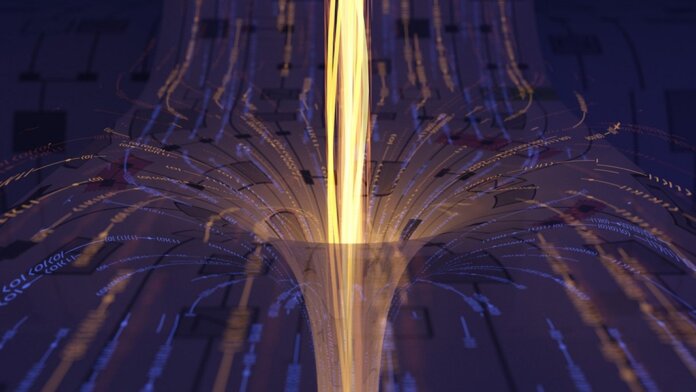Wormholes might sound like something that belongs in a Star Trek episode rather than a research paper, but scientists just simulated one on Google’s Sycamore quantum computer. The result suggests these devices could be used to test out fundamental physical theories.
The possibility of wormholes was first outlined in a 1935 paper by Albert Einstein and Nathan Rosen. In broad terms, they described a bridge in space-time that connects two black holes in different locations. Science fiction shows have frequently depicted these bridges as a way to rapidly travel from one location to another by flying a spaceship into one end and popping out the other.
In the real universe, however, wormholes are generally not traversable and will promptly collapse if anything attempts to pass through. But there are some theories that suggest exotic phenomena such as matter with negative energy could help prop open a wormhole long enough to allow something to pass through.
Seeing as we’ve never even encountered a real-world wormhole, these ideas are hard to test experimentally. But now, researchers have shown that they can use a quantum processor to simulate key aspects of this kind of traversable wormhole in the lab.
“We found a quantum system that exhibits key properties of a gravitational wormhole yet is sufficiently small to implement on today’s quantum hardware,” study leader Maria Spiropulu, from Caltech, said in a press release. “This work constitutes a step toward a larger program of testing quantum gravity physics using a quantum computer.”
The experiment relied on a powerful idea from theoretical physics called the holographic principle, which attempts to link our two best theories of how the world works—quantum mechanics and general relativity—which are incompatible in their present form.
The idea gets its name from holograms—2D surfaces that can project a 3D image. In the same way, the holographic principle posits that all of the information required to describe the complex 3D reality we live in is actually encoded on a distant 2D surface.
While that might be hard to get your head around, a crucial consequence of the idea is that it sets up a mathematical link between the classical physics of general relativity and the mind-bending world of quantum mechanics. A chunk of 3D space time described by the former is equivalent to a system of quantum particles on the distant 2D surface.
Beyond solving the fundamental questions of the cosmos, this “duality” makes it theoretically possible to design quantum systems that are equivalent to macroscopic structures in space time. This is exactly the approach that Spiropulu’s team used to simulate a traversable wormhole on a nine-qubit quantum circuit, as described in a paper published in Nature.
Their experiment built upon a body of work that suggests that two sets of particles with a particular pattern of entanglement can be mathematically equivalent to a pair of black holes linked by a wormhole. More importantly, quantum teleportation of information between these two sets of particles is equivalent to quantum information passing through the wormhole.
To test the idea out, the researchers implemented this quantum system on the Sycamore processor and then fed a single unit of quantum information, or qubit, into one set of particles. They then saw it emerge from the other set of particles, but crucially, it exhibited the same dynamics as would be expected while crossing a traversable wormhole at larger scales.
For a start, they found that the information only teleported when they applied quantum equivalents of the negative energy that is needed to make wormholes traversable. They also detected a small delay in transmission and a particular pattern in the way information is scrambled and unscrambled, which are unique to the way information should travel through a wormhole.
It’s important to point out, though, that the experiment comes with all kinds of caveats. The wormholes the group were simulating, and indeed, even the holographic principle on which they’re based, exist in a hypothetical kind of universe that operates very differently from our own. In addition, their experiments assumed only two dimensions: one spatial dimension and the dimension of time.
Their model of the wormholes also had to be severely truncated. To implement them in full would have required far more qubits than any quantum processor is likely to have in the near future. So to make their model workable on today’s smaller devices, they borrowed an idea from machine learning called “sparsification,” which reduces the size of models while preserving certain key characteristics. They used this process to simplify their model while ensuring it still preserved the signature associated with negative energy propping the wormhole open.
The team did find evidence that this process hadn’t stripped too much of the detail out of the model, though. The distinctive scrambling and unscrambling pattern showed up, despite the model not having been trained to preserve it. Nonetheless, whether the experiment truly represents the dynamics of a wormhole is an open question. “If you want to see this as a wormhole, there are a number of parallels, but it’s definitely a matter of interpretation,” Adam Brown, from Stanford University, told New Scientist.
Given the small size of the quantum system used, it’s also entirely possible to carry out this simulation on a conventional computer. But the value of this work may lie less in the specific experiment that the researchers carried out, as in a proof-of-principle that quantum computers could help test ideas in theoretical physics that would be hard, or impossible, to probe experimentally.
“The relationship between quantum entanglement, spacetime, and quantum gravity is one of the most important questions in fundamental physics and an active area of theoretical research,” Spiropulu said. “We are excited to take this small step toward testing these ideas on quantum hardware and will keep going.”
Image Credit: inqnet/A. Mueller (Caltech)



